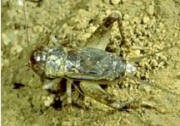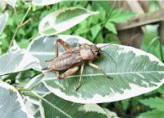
- An adult is about three-fourths inch (19 mm) long with three dark bands on the head with long thin antennae.
- The body is light yellowish brown. House Crickets remain hidden during the day and become active at night. They feed on almost any food found around the home.
- Usually found in warm areas where they can get enough moisture and food.
- In the winter they are often found near fireplaces, kitchens, water heaters and furnace areas
- Each female can lay an average of 728 eggs with the immature
(nymphs) resembling the adults except being wingless.

- Nymphs molt seven to eight times and reach adulthood in about 60 days.
- Also, these crickets can live indoors, completing their life cycle with eggs laid in cracks, crevices and other dark areas such as behind baseboards
- Damage plant seedlings, seeds of grain crops, alfalfa, strawberries, tomatoes and other vegetable crops.
- Damage stored tubers or fruits. In hay meadows, crickets can chew through bale twine
- Chew on clothing, draperies or furniture upholstery. They particularly like fabrics containing organic materials such as cotton, silk and wool
- Reduce hiding places around the perimeter of homes and buildings to discourage build up of cricket populations.
- Removal of dense vegetation, loose bricks, boards, wood piles and other debris minimizes hiding places.
- Deny entry to crickets in homes by sealing cracks and gaps around the foundation, loose-fitting doorways and hose/wire entrance points (e.g., electrical, air conditioner, cable etc.).
- Seal entry points either by caulking cracks and crevices, or by using weather stripping for tighter-fitting garage and other entry doors.
- Insecticides registered for cricket control are available in
various formulations such as aerosols, baits, dusts, granules,
 emusifiable concentrates (EC), soluble concentrates (SC) and wettable
powders (WP).
emusifiable concentrates (EC), soluble concentrates (SC) and wettable
powders (WP). - Insecticide products available locally may contain active ingredients as follows: bifenthrin, cyfluthrin, cypermethrin, deltamethrin, esfenvalerate, permethrin and pyrethrins. Insecticide aerosols are very useful to kill one or a few crickets, but they may not be as effective as more general, residual insecticides